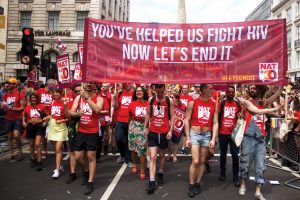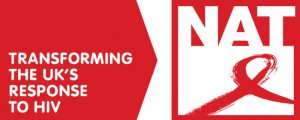The National AIDS Trust has been at the forefront of decisions and policies about HIV since it formed in 1987. More recently NAT successfully challenged NHS England in the High Court about the availability of PrEP. We asked Yusef Azad, Director of Strategy at NAT, whether we can reach zero transmissions of HIV in the UK and what the hurdles are?
We have seen in the UK astonishing drops in the numbers being diagnosed with HIV. In 2017, there were 4,363 people newly diagnosed with HIV – that’s down 28% from the 6,043 new diagnoses two years previously in 2015. This decline has been especially marked among gay and bisexual men, where diagnoses have dropped by 31% since 2015, to 2,330 in 2017. Before 2015, diagnoses had been increasing year-on-year. London especially has witnessed amazing drops in diagnoses – in those two years diagnoses fell by 44%, almost halved in other words!
Whilst these reductions began with gay men in the bigger London clinics, it is now great to see drops in diagnoses across the country and also among heterosexuals. There have been drops in diagnoses in African communities for a few years but for the first time in 2017 we also saw a significant drop in new diagnoses of 20% among other heterosexuals.
Of course one way to have fewer diagnoses is to stop testing people! But that isn’t the explanation – HIV testing rates continue to increase, especially among gay men. These drops in numbers diagnosed reflect fewer people actually getting HIV. We’re turning the epidemic around. So how is it happening?
There are a number of factors all coming together to secure this turnaround – indeed, the phrase ‘combination prevention’ is used to emphasise the fact that there is not one single factor which is now reducing HIV transmission. It is about a number of different approaches all being implemented together.
Continuing high rates of condom use among gay men are a fundamentally important contribution. Another key factor is increased HIV testing. And not just more people testing but more people testing repeatedly and regularly. This has been driven by sexual health clinics, by strong health promotion work in our communities with a testing focus in recent years (including National HIV Testing Week), new technologies such as self-sampling and self-testing, and new places to test such as A&E, GP practices and in the community.
If people with HIV get diagnosed soon after getting infected, they can be put on treatment that much sooner. We know that U=U (undetectable = untransmittable), that treatment brings the amount of virus down to such low levels that the person becomes non-infectious. So increased testing is the gateway to making people with HIV incapable of passing HIV on.
This process has also been accelerated by changes to the guidance as to when someone with HIV should start treatment. People used to be told to wait to start treatment until their immune system had deteriorated to a certain point but recently this has changed and someone diagnosed with HIV is now recommended to start treatment immediately. So again the person becomes non-infectious that much more quickly.
Then there is PrEP which gay men started to access first in the PROUD study in 2013, then in larger numbers online from the end of 2015 as a result of the work of the Iwantprepnow website, and then on the NHS via the Impact trial from the end of 2017. Whilst we cannot yet quantify the contribution of PrEP to these drops in diagnosis, given the numbers of gay men on PrEP and its effectiveness I have no doubt that it is playing a major role in reducing HIV transmission.

These reductions in HIV transmissions suggest that the elimination of HIV transmission in the UK is now a real possibility. Indeed the United Nations have committed to eliminating all new HIV transmissions by 2030. This commitment is being picked up by others. The Fast-Track City initiative across the globe is getting cities to commit to a number of international HIV targets and one of them is elimination of new HIV transmissions by 2030. Brighton, London and Manchester are fast-track cities in the UK, and others may follow. These cities will be planning how to get to zero new infections over the next few years.
There is, however, still much more work to do before we see the elimination of new HIV transmissions in the UK. There is a risk with the success we’ve seen that politicians, funders and decision-makers, and indeed our own community, think ‘job done’ and move on to other matters. That would be a tragic mistake. For a start, it is an injustice for those who are not yet benefiting, or not benefiting as much, from these successes – BME gay men, women, migrants, trans people, heterosexual men. We need everyone across all groups to benefit from reductions in transmission. Secondly, if we don’t go forward we’ll go backwards. Delays in fully implementing PrEP, funding cuts to sexual health clinics and to health promotion work – these risk us going into reverse and seeing HIV transmissions on the rise again.
Another thing we must remember is that we are talking about the elimination of new HIV transmissions. There are well over 100,000 people living with HIV in the UK and they will continue to do so. There is a lot of interest in cure research but everyone agrees that a cure is still a long way off. So this understandable and exciting focus on elimination must not drain attention and funds away from people actually living with HIV, who still need high quality clinical care and medication, as well as, in many cases, a range of wider support services, including effective action against stigma. And will need them for decades to come.
Just because HIV rates are falling that does not yet mean the epidemic is over – gay and bisexual men remain at significant risk because of high rates of HIV in our community. We still need to think about our HIV risk if we are currently HIV negative, test for HIV, and decide how best to have safer sex taking advantage of the options available to us.
But the elimination of HIV transmission as a significant health risk is achievable – if we act to make it so. The success so far is down to all of us – all of us who’ve worked or volunteered for HIV and sexual health organisations, all of us who have donated time and money to the HIV response, all of us who have shown solidarity by wearing a Red Ribbon around World AIDS Day, who have told others about safer sex or have challenged HIV stigma. And we have done it in partnership with amazing NHS services and with many other committed people outside the gay community. It is something that we can as a community be very proud of. Now is not the time to stop – let’s finish the job!

Read more about NAT’s work at nat.org.uk














